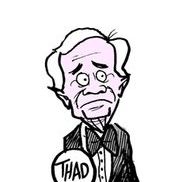From the Right
/Politics
A Fail-Safe Society Is Sure to Fail
When are we going to trust our fellow Americans again? When are we going to allow qualified individuals with responsibility to make decisions without consulting detailed rulebooks and formal procedures?
Those are questions New York lawyer and author Philip K. Howard (one of whose books is called, simply, "Try Common Sense") asks in his latest ...Read more
Disorder on the Border Remains a Problem for Biden Democrats
What were they thinking? Did President Joe Biden and the folks who put together his immigration policy imagine the voting public would celebrate policies that resulted in a record-high number of migration encounters -- more than three-quarters of a million -- in the usually low-immigration months of October, November and December 2023?
Did they...Read more
Today's Leaders Are Not Living Up to Constitutional Norms
How are America's leaders measuring up against the standards set by the Constitution and the examples of the Founding Fathers? It's a question I've been asking as I seek refuge from contemporary politics in reading and occasionally writing, in my 2023 book "Mental Maps of the Founders," about the early years of the republic.
One answer is that ...Read more
The Electric Car Fiasco
Donald Trump's anodyne if overexcited comment that the U.S. auto industry would face a "bloodbath" if he's not elected and doesn't impose 50% or 100% tariffs on cars produced predictable results.
"Don't outsmart yourself," Sen. Brian Schatz (D-Hawaii) posted, and Joe Biden's campaign promptly charged Trump with promising a "bloodbath" if he ...Read more
Democrats Losing Their Hold on California and California Losing Its Hold on America
Last week's Super Tuesday results ensured the renominations of former President Donald Trump and President Joe Biden, barring some unanticipated adverse health events. So, who's going to win in November?
Polls give us clues. Trump continues to have the small but persistent lead in public polls he has maintained since November 2023 -- in ...Read more
Are Voters Recoiling Against Disorder?
The headlines coming out of the Super Tuesday primaries have got it right. Barring cataclysmic changes, Donald Trump and Joe Biden will be the Republican and Democratic nominees for president in 2024.
With Nikki Haley's withdrawal, there will be no more significantly contested primaries or caucuses -- the earliest both parties' races have been ...Read more
Some Idiosyncratic Observations of the Elections So Far
Herewith some idiosyncratic, perhaps eccentric, observations on the electoral contests so far in this presidential cycle.
1. Turnout is down. In the first five contests -- the Iowa and Nevada caucuses and the New Hampshire, South Carolina and Michigan primaries -- Republican turnout was down from 2016, the most recent cycle with serious ...Read more
Biden Open-Door Policy: Some Facts and Historical Context
What's been missing these past couple of months from the coverage of and debate over the failed immigration bill? Some important basic facts and lots of historical context.
First, basic facts. Coverage in left-leaning newspapers and even in the conservative Wall Street Journal editorial page has suggested that without new legislation, the Biden...Read more
America's Dysfunctional Overclass
What does America's overclass think of the rest of us? The short answer is "not much." They think ordinary people's splurging on natural resources is destroying the planet and needs to be cut back forcefully. And that the government needs to stamp down on ordinary people enjoying luxuries that, in their view, should be reserved for the top ...Read more
Toward a Demotic Republican Party
What happens when a political party becomes demotic? Before answering the question, note that the word in question is not demonic, from the Greek word daimon, meaning a deity (remember that the Greek gods were notoriously jealous and greedy), but demotic, from the Greek word demos, meaning the people -- the same root as democratic.
My question ...Read more
Systemic Lying Corrodes Once-Great Institutions
The last six or seven months have been a couple of tough seasons for public policies based on lies. Two examples come to mind. One is the Disinformation industry, which has eroded the credibility of the public health establishment. The other is the Diversity, Equity, Inclusion industry, which has infected American higher education with a culture...Read more
DeSantis Withdrawal Paved the Way for Likely Trump-Biden Rematch
What went wrong with Ron DeSantis' presidential campaign? You can list many arguable mistakes, as you can with any campaign, and you can add, as some reporters have, that the candidate was not likable or good at retail campaigning -- which mostly reflected reporters' personal dislike of DeSantis or resentment at his refusal to schmooze what he ...Read more
No Gary Hart Bounce for DeSantis or Haley
Forty years ago, when Walter Mondale won 49% in Iowa's Democratic caucuses, far ahead of Gary Hart's 16%, the media spotlight nonetheless immediately focused. With the help of a brilliant spot by consultant Ray Strother showing him tossing a hatchet into a tree, Hart went on to win the New Hampshire primary eight days later, 37% to 28%, and he...Read more






